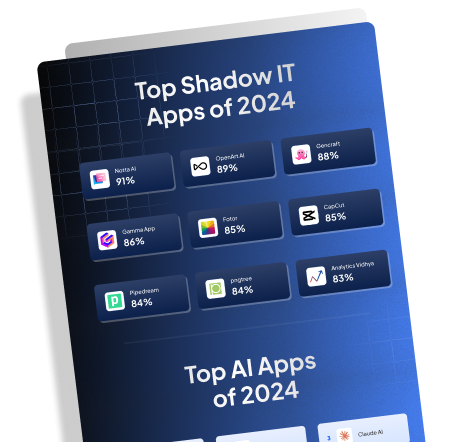What is Business Impact Analysis?
Business Impact Analysis (BIA) is a strategic exercise to identify and evaluate the potential effects of interruptions on your organization’s business processes. As the heart of the business impact assessment, it works to predict the consequences of disruption and provide a roadmap for recovery, enhancing business resilience. Integral to the overall business impact planning, it is a critical risk management component.
Note: Transform your business into a more resilient and cost-effective IT operation with Torii. Uncover hidden risks and optimize your IT systems effectively. Identify and mitigate vulnerabilities, reduce costs, and enhance your strategy against unforeseen incidents with Torii’s Shadow IT Discovery. Check out Torii’s Shadow IT Discovery
What does a comprehensive business impact analysis process entail? It involves diligent steps, from pinpointing possible risks to finding viable solutions. Advanced business impact analysis tools facilitate this process, along with a well-crafted business impact analysis template to organize and present the collected data effectively. This systematized approach constitutes what we call the business impact analysis methodology.
Notably, the business impact analysis framework is not a one-fits-all concept. It is scalable and adaptable to suit the individual needs of an organization. However, standard components of this framework often include risk identification, business process analysis, recovery strategy development, and documentation in a business impact analysis report.
Examining real-world business impact analysis examples can provide significant insights. For instance, an unforeseen infrastructure failure can demonstrate how business impact analysis measures are implemented. The risk is initially identified and mitigated using the business impact analysis mitigation strategies. The availability of a well-designed business impact analysis questionnaire simplifies data collection, whereas the adoption of robust business impact analysis recovery plans ensures business continuity.
However, the utility of BIA continues after recovery. Its in-depth metrics enable the review and refinement of systems to better respond to future incidents, contributing to disaster resilience. Through accurate business impact analysis metrics, organizations can glean their vulnerabilities, benchmark their performance, and monitor their progress over time.
Lastly, evaluating the business impact analysis risk holds paramount importance. Risks addressed range from data breaches technical failures, to natural disasters. Appropriate risk measures, disaster mitigation, and clearly defined incident responses are all outcomes of a thorough business impact analysis. Consequently, executing an efficient BIA builds a firm foundation for sustained business success, even in adversity.
Healthcare Business Setting
Stride Health, a health insurance broker, performed a comprehensive business impact analysis (BIA) as a step in their disaster recovery planning. Stride used a business impact analysis template to identify critical operational functions, focused on business impact analysis measures, followed by a thorough business impact evaluation. This systematic business impact analysis helped them identify the situations that could significantly disrupt their services, like cyber-attacks or natural disasters. With this information, they were well-placed to create an effective business impact analysis recovery plan to enhance their business resilience.
Non-Profit Organization
Torii’s SaaS Management Platform exemplifies how a BIA methodology can be deployed in the IT sector. Yours Humanly, an international non-profit organization, evaluated its IT systems using Torii’s platform for business impact analysis. They discovered several Shadow IT programs in use, which posed significant risks. By using this business impact analysis tool, Yours Humanly identified potential vulnerabilities and areas for cost savings. Plus, through the automation of SaaS operations, they enhanced their mitigation strategy for any unforeseen incidents as part of their business impact planning.
Financial Institution
In finance, U.K. banking giant Barclays had to undertake a robust business impact analysis for the new digital transformation initiative. Barclays used a specialized business impact analysis framework to assess the prospective impacts of the proposed changes on its operations. By quantifying the business impact analysis metrics, the bank identified potential risk areas and implemented necessary safeguards. This approach ensured that planned changes wouldn’t adversely affect the bank’s performance or customer service levels, effectively improving resilience to any potential disaster.
These examples underline the significance of a well-structured business impact analysis process for assessing potential threats and building effective strategies in healthcare, non-profit IT management, or financial services sectors.
Best Practices for Business Impact Analysis
The best practices of Business Impact Analysis (BIA) pivot on a tactical, step-by-step framework.
- Business Impact Planning
BIA begins with business impact planning. This planning phase seeks to align business continuity objectives with top-level business strategy.
- Business Impact Assessment
Right after this step is the business impact analysis process, which includes implementing a business impact assessment, this assessment is about creating a detailed, prioritized list of business functions and systems, meticulously measuring their potential impact should an interruption occur.
- Undergo Business Impact Evaluation
Next comes the business impact evaluation stage. Here, business processes are scrutinized, considering the impacts of downtime and recovery time objectives. Part of this process involves leveraging a business impact analysis template outlining the crucial elements to consider.
- Review and Update Business Impact Analysis Methodology
A business impact analysis methodology follows where you establish a practice to regularly review and update BIAs as business operations and technologies evolve. This methodology utilizes various business impact analysis tools to ensure thorough and accurate results.
- Create Insight Report
The results are encapsulated within the business impact analysis report. This report provides a comprehensive summary of the findings from the BIA and is crucial for ongoing business impact planning. This report should offer meaningful business impact analysis examples to aid decision-making. It should also detail the steps taken for the business impact analysis.
- Gather Insights through the BIA Questionnaire
A comprehensive business impact analysis questionnaire is another best practice that helps gather deep insights from across the organization. This includes understanding stakeholders’ needs and vulnerabilities and enabling effective business impact analysis recovery strategies.
- Create BIA Metrics
Consequently, accurate business impact analysis metrics are applied, converting qualitative information into quantitative data. This specificity level helps fine-tune the business impact analysis measures and adds precision to the risk measurement.
- Risk Assessment
Understanding risk is essential, and a business impact analysis risk assessment is a crucial. It helps to evaluate the likelihood of disruptions and how they can impact critical business functions.
- Risk Mitigation
The focus then shifts to business impact analysis risk mitigation building incident response plans to minimize the damage if disruptions occur. Business impact analysis incident response actions should include procedures for disaster recovery to prepare for worst-case scenarios.
- Adapt BIA Resilience
The final step is business impact analysis resilience. Adapting to new risks and constantly refining the BIA process ensures the business can withstand and recover from unexpected disruptions.
Throughout this entire process, the Torii SaaS Management Platform provides notable advantages. It enables IT Managers and Directors to streamline processes, offering visibility over SaaS expenditures, discovering Shadow IT, and optimizing SaaS operations. This lends itself to cost savings, better insights, and more efficient disaster recovery, enhancing overall business resilience.
Related Tools for Business Impact Analysis
- Torii SaaS Management Platform
- Cleanshelf
- CoreView
- Binadox
- Snow Software
Related Concepts in Business Impact Analysis
- Business impact analysis: Process of evaluating the potential effects, consequences, and risks of business interruptions or incidents on an organization’s operations, resources, reputation, and financial health.
- Business impact assessment: The evaluation and determination of a disruption or incident’s impact on an organization’s business processes, functions, and objectives.
- Business impact evaluation: The assessment and analysis of the magnitude and significance of the consequences, disruptions, or damages caused by an incident or disruption to the organization’s operations.
- Business impact planning: The strategic planning and preparation undertaken to mitigate, manage, and respond to potential business disruptions or incidents based on the findings of the business impact analysis.
- Business impact analysis process: The systematic approach and steps followed in conducting a business impact analysis, including identifying critical business functions, assessing risks, and analyzing impacts.
- Business impact analysis template: A pre-designed format or structure that provides a framework for conducting a business impact analysis, typically including sections for identifying critical processes, impacts, risks, and recovery strategies.
- Business impact analysis methodology: The specific approach, techniques, and procedures used to carry out a business impact analysis, ensuring consistency and repeatability in the analysis process.
- Business impact analysis tools: Software applications or specialized tools used to support and facilitate the business impact analysis process, often providing features like risk assessment, impact mapping, and reporting functionalities.
- Business impact analysis framework: A structured framework or model that guides conducting a business impact analysis, typically outlining the key steps, considerations, and components involved.
- Business impact analysis report: A documented summary of the findings, results, and recommendations of a business impact analysis, often used to inform decision-making, risk management, and business continuity planning.
- Business impact analysis examples: Illustrative instances or scenarios demonstrating the potential impacts and consequences of specific incidents or disruptions on an organization’s operations, typically used within a business impact analysis.
- Business impact analysis steps: The sequential actions and activities involved in conducting a business impact analysis, such as scoping the analysis, identifying critical functions, assessing impacts, and developing recovery strategies.
- Business impact analysis questionnaire: A survey or structured set of questions used to gather data and information about critical business functions, dependencies, and potential impacts, typically administered to key stakeholders.
- Business impact analysis recovery: The process of identifying and implementing measures, strategies, and actions for recovering critical business functions and resuming normal operations following a disruption or incident based on the business impact analysis findings.
- Business impact analysis metrics: Measurable variables or indicators used to assess, quantify, and evaluate the impacts, consequences, and risks identified during the business impact analysis process.
- Business impact analysis measures: Specific actions, controls, or strategies implemented to mitigate, reduce, or manage the impacts and consequences identified through the business impact analysis.
- Business impact analysis risk: The potential for harm, loss, or adverse effects on an organization’s operations, resources, or objectives resulting from a disruption, incident, or external factors identified through the business impact analysis.
- Business impact analysis mitigation: Implementing actions, strategies, and measures to reduce or eliminate potential risks, impacts, or vulnerabilities identified through the business impact analysis.
- Business impact analysis incident: An unexpected event, occurrence, or disruption that affects an organization’s operations, functions, or resources and may result in negative consequences or impacts, as identified through the business impact analysis.
- Business impact analysis disaster: A severe event, circumstance, or occurrence that causes significant harm, destruction, or disruption to an organization’s operations, assets, or capabilities, as identified through the business impact analysis.
- Business impact analysis resilience: The ability of an organization to withstand, adapt to, and recover from disruptions, incidents, or adverse events, as assessed and enhanced through the business impact analysis process.
FAQs: Business Impact Analysis
Q: What is Business Impact Analysis (BIA)?
A: Business Impact Analysis (BIA) is a process that identifies potential impacts on a business during a disruption or disaster.
Q: Why is Business Impact Analysis critical?
A: Business Impact Analysis is critical because it helps organizations assess the potential impact of disruptions and prioritize their recovery efforts accordingly.
Q: What are the benefits of conducting Business Impact Analysis?
A: Conducting Business Impact Analysis gives organizations insights to prioritize critical business functions, allocate resources effectively, and develop robust recovery plans.
Q: How is Business Impact Analysis different from Risk Assessment?
A: While Risk Assessment identifies potential risks and vulnerabilities, Business Impact Analysis focuses on understanding the impact of disruptions on business operations.
Q: What are the steps involved in conducting a Business Impact Analysis?
A: The typical steps in conducting a Business Impact Analysis include identifying critical business functions, determining potential impacts, quantifying impact severity, and developing recovery strategies.
Q: Who should be involved in the Business Impact Analysis process?
A: The Business Impact Analysis process should involve key stakeholders and subject matter experts from various organizational business units.
Q: What tools can I use to perform Business Impact Analysis?
A: Various tools like questionnaires, interviews, and data analysis techniques can be utilized to perform Business Impact Analysis.
Q: What is the output of a Business Impact Analysis?
A: The output of a Business Impact Analysis is a comprehensive report that outlines critical business functions, impact severity, recovery priorities, and recommended strategies.
Q: How often should a Business Impact Analysis be conducted?
A: Conduct a business impact analysis periodically or whenever significant business operations or risk landscape changes are recommended.
Q: What are some common challenges in conducting a Business Impact Analysis?
A: Common challenges in conducting a Business Impact Analysis include obtaining accurate inputs from stakeholders, ensuring data reliability, and managing the complexity of interconnected business processes.
Q: How can I use the results of a Business Impact Analysis?
A: The results of a Business Impact Analysis can be used to prioritize resource allocation, guide disaster recovery plans, and make informed decisions to mitigate potential business disruptions.
Q: Are there any industry best practices for Business Impact Analysis?
A: Yes, industry best practices for Business Impact Analysis include involving cross-functional teams, validating assumptions, and aligning the analysis with the organization’s risk management framework.
Q: Can I outsource Business Impact Analysis to a third-party consultant?
A: Yes, organizations can outsource Business Impact Analysis to specialized consultants with expertise in this area.
Q: How long does it take to complete a Business Impact Analysis?
A: The duration of a Business Impact Analysis can vary depending on the size and complexity of the organization, but it typically takes several weeks to a few months to complete the process.





